This year my wife Kim and I sat down with our two children, eight and 11 years old, and decided we were going to begin planning and executing backpacking adventures throughout the world. The first thing we had to do was figure out if the kids were up to it, or even would enjoy these types of expeditions. As a family we began doing research, mostly online, about the different trails around the world to get ourselves excited, and then we began a series of ever increasing day hikes.
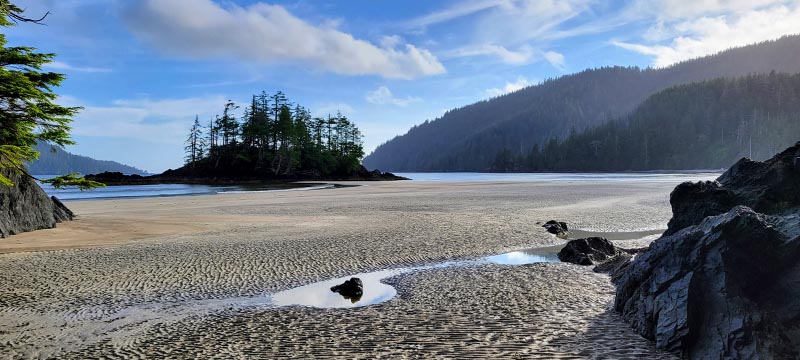
For our first big trip we decided on the West Coast Trail which ends in Bamfield BC, where we happen to have a cabin. The kids had of course heard about the West Coast Trail, as it’s famous not only around the world but also locally, but were extra excited that we’d be able to end the trip sitting on our deck overlooking Barkley Sound.
We then decided that we needed to get a preparation trip on the books, so a month before we would leave for the West Coast Trail we drove up to Port Hardy to tackle the Cape Scott Trail to the northern tip of Vancouver Island.
Kim and I had done the Cape Scott Trail in the past, as part of a trip that brought us not only into Cape Scott Park but down the North Coast Trail. In fact the gentleman that drove us to the trailhead at the time told us we are one of the first 200 people to ever hike the North Coast Trail. We found the North Coast Trail to be reminiscent of the West Coast Trail but, at least at the time, with far fewer ladders, boardwalks and facilities.
The Cape Scott Trail, is in Cape Scott Provincial Park. The main draw of this trail is the beautiful West Coast and East Coast Vancouver Island beaches, and the manned lighthouse at the northerly tip of Vancouver Island. The trail is also famous for its history, has two settlement attempts began in the area in the late 19th and early 20th centuries. Throughout the hike you will see remnants of this early settlement, both in terms of how it changed the landscape, and through artifacts themselves such as farming implements, building ruins, and even grave sites.
Our Trip to the Cape Scott Trail Begins
On July 15th we set off in the truck from our home in the Alberni Valley for a 6-hour drive to the trailhead. Most of the drive was done on paved roads but the last hour or so was on gravel logging roads. Because the drive is long and the first day of hiking to the first beach at either Nissen or Nel Bight is about 20+ kilometers, we decided to take the first night to walk an easy 45 minutes along the flat, well maintained, trail to San Josef Bay. San Josef Bay is a spectacular beach on the west coast of Vancouver Island and was a perfect place to camp for the first night. The boys team and the girls team set up our tents for the first time, got everything ready at camp, and then set off to explore the beach. The beach is home to some spectacular sea stacks and small sea caves, and we all had fun exploring.
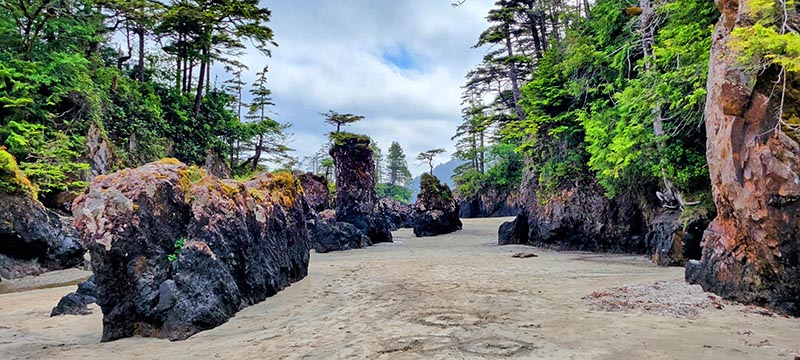
Day Two – The Hike to Nels Bight
We woke up early in the morning, packed up our tents, had a cold breakfast, and began the hike to Nels Bight. The trail was reported to be about 18 km from San Josef Bay and would walk through inland rainforest the entire day. Once we got off the main trail from San Josef, and on to the trail leading to Nels Bight. the trail itself changed. Gone forever was the wide gravel pathway, replaced by roots and mud.
The first landmark we saw was Eric Lake which was about 4 km into our hike. At the Eric Lake campsite we stopped and filtered water for the day ahead. Following the lake was a long day of hiking through the thick forest. After some hours, the landscape changed and we emerged from the darker forest into the more open bogs. We knew from experience this meant we were getting close to the T that leads to either Nissen bite or Nels Bight. It’s around this time that we started to see remnants of the early settlers.
The first artifact we found was the downed telegraph line along the trail. Just before arriving at the T we came across what must have been the main settlement area in the early 20th century. Here we discovered the Christensen Homestead, marked by artifacts, beautiful large trees that were not natural to the landscape, and the Christensen grave where they buried a young son. Exploring the side trails in this area we found other artifacts, homestead sites, and a graveyard.
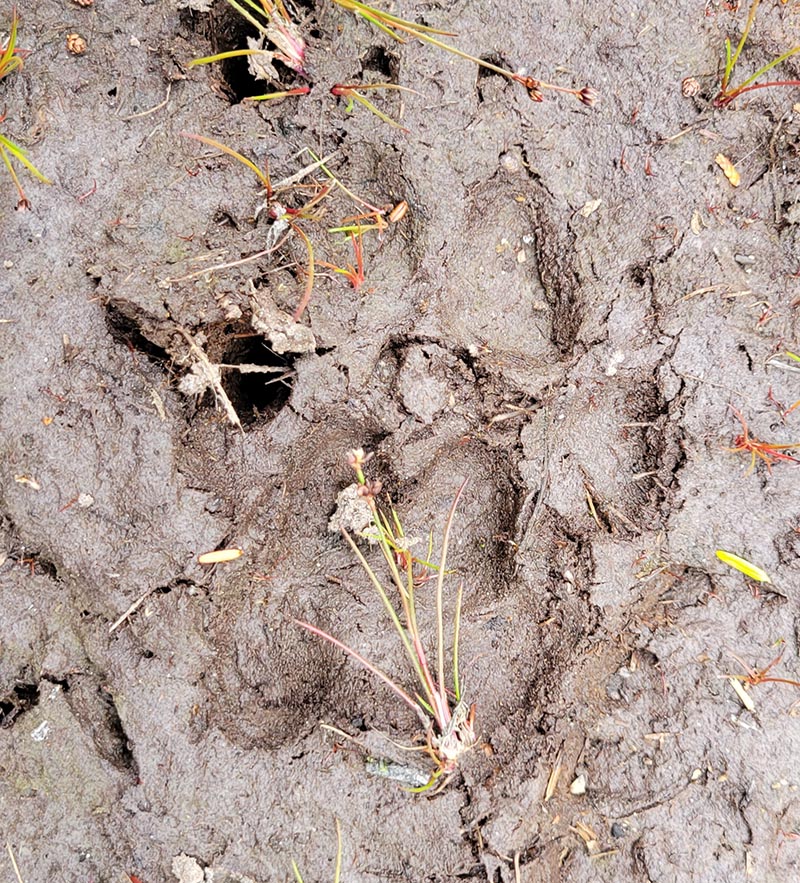
We chose Nels Bight to spend the night, as most people do. Nels Bight is a spectacular beach on the east coast of Vancouver Island, and a great place to base camp for day excursions to the lighthouse. Because we saw so few people as we hiked that day, we were surprised by the number of people camping at Nels. The beach was packed! But there was still plenty of room for us. We set up camp, made the walk to filter what we affectionately came to call swamp water, and prepared dinner while the kids played on the beach. Where they got the energy to run and play, I’ll never know.
Day Three – All the Way North
We woke up to a beautiful summer Vancouver Island morning with stiff legs. Our Garmin watches told us, that we had hiked a total of 20.98 km the day before. Today was the day we were all looking forward to – the push to the lighthouse!
We set out along Nels Bight beach, and then took the inland trail up through a beautiful Forest overlooking the ocean for a short time, until we arrived at Experiment Bight. The normal thing to do at Experiment Bight it is to walk the beach for a ways, and then head back into the trail that crosses across Vancouver Island to reach Guise Bay. Having done this hike before, we knew there were some spectacular sand dunes just past the Experiment Bight. We were blessed with an exceptionally low tide, so made the decision to forgo the trail, and push along the beach until we hit the sand dunes. This is not something I would recommend doing unless you know where you’re going and the tide is very very low. Along this route we found a stunning sea arch and stopped to take some pictures.
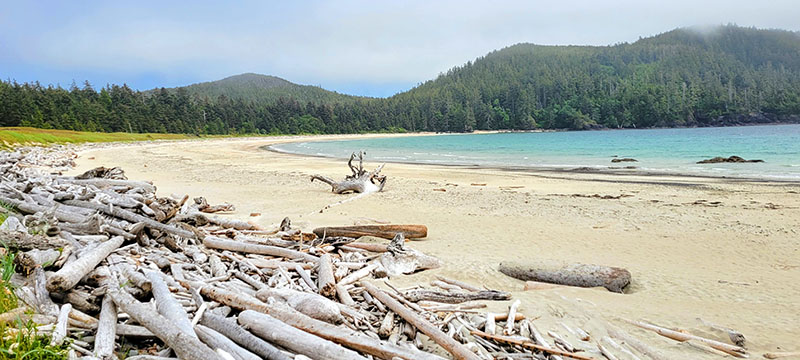
Finally we arrived at the sand dunes. History tells us that these sand dunes were once pure sand moved, shaped by the wind, but that an early settler in the area planted clover in order to try to stabilize the dunes. This settler’s fence posts are still visible along the beach.
Once we got there, we did something that I never thought I could say in my life – we crossed from the east coast of Vancouver Island all the way to the west coast of the Vancouver Island over sand dunes! Of course, because we’re so far north this crossing took less than 15 minutes. We arrived at Guise Bay which is undoubtedly the most beautiful beach in Cape Scott Provincial Park.
From Guise Bay we pushed inland up through the well-maintained trail that led to the Cape Scott Lighthouse. This was the second time that I visited the lighthouse, and both times there was so much fog you couldn’t see the ocean. Still the well manicured and maintained grounds of the lighthouse was a sight to behold and a symbolic victory for our trip. The friendly Lighthouse Keeper came out and spoke with us, offered us fresh filtered water, and told us a little bit about her job living in this remote lighthouse. With filtered water in our bottles, and a warm meal on a picnic table, we felt like we were in civilization, which was strange given the challenges it took to arrive here!
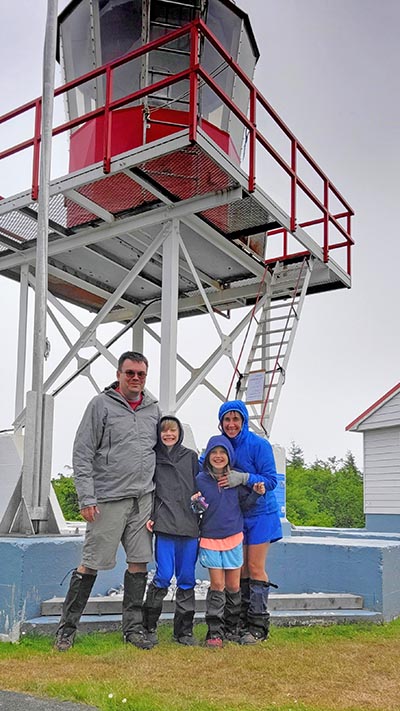
We spent the afternoon making our way back to our base camp at Nels Bight through the regular inland forest trail and had a beautiful evening camping on this exceptional beach.
Day Four – Time to Go Home
We woke up in the morning feeling really good about what we’d accomplished. The kids had done amazing and had not complained throughout the entire trip. But, we knew today was going to be a challenge, as we were going to push from Nels Bight all the way back to the trailhead on very tired legs.
The 20 km hike back to the trailhead took us through familiar territory. It was without question, the most physically challenging day of the trip. Kim and I know from experience that when the going gets tough there’s a few ways you can respond: it’s easy to get inside your head and begin the process of commiserating your suffering; or you can become quiet and just soldier on; but what we’ve learned works best is humor. So we crack jokes along the way, and the suffering mingled with laughter. The kids dressed themselves up as swamp creatures and did much of the hike looking like an animal coming out of the forest.
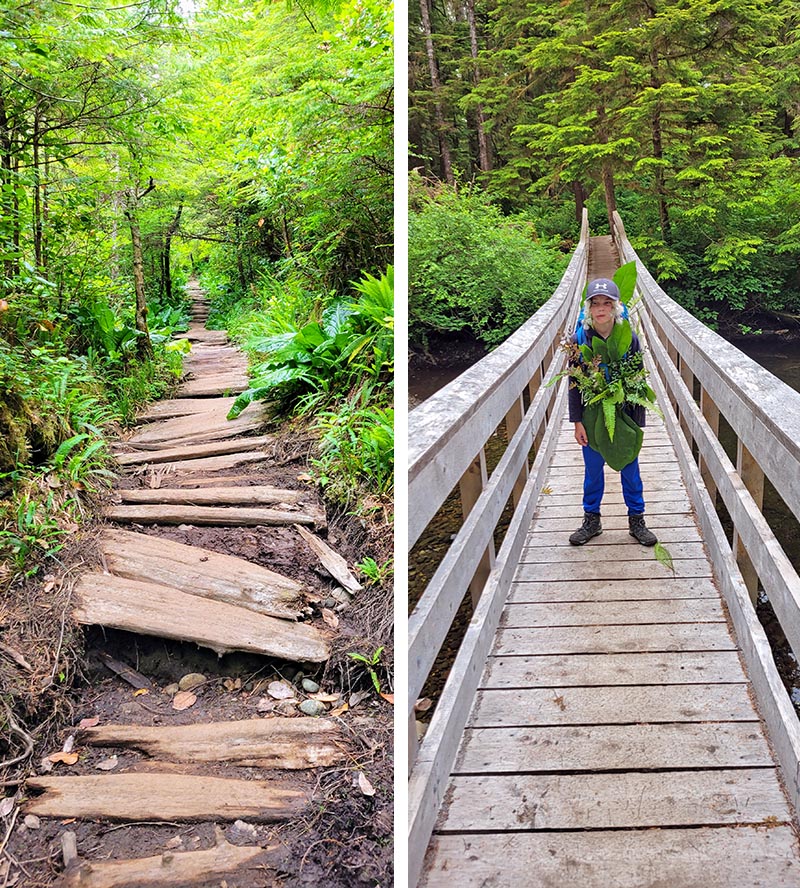
After a lunch break at Eric Lake we did the final push through to the truck. It was such an incredible feeling for the four of us, as a team, to finish this challenge which was the hardest of the kids’ lives. We got in the truck, drove back to Port Hardy and stayed the night in a hotel. In Port Hardy we enjoyed a three course meal (aka three dinners) and then slept on what seemed like the most comfortable beds in the history of mankind.
Final Thoughts
Backcountry expeditions with kids is a very rewarding experience. To do it right takes preparation. We started with half day hikes, moved on to full day hikes, and then started adding weight to our packs for these full day hikes. We talked to the kids throughout this preparation about the suffering that they would face, the walls they would hit, and the stories that about suffering they would naturally tell themselves in their head. We discussed working as a team, making sure that when one person was suffering everybody else worked consciously to raise them up. Most importantly I think as adults we have to model the behavior, so it’s important when the going gets tough, that we get into humor and grit through it with a smile on our face. I think the best part about the experiences is that you teach your kids that amazing feelings and experiences come at the end of a day of hard work.
When it was all said and done, we hiked 61km, through one of the most beautiful and diverse areas of Vancouver Island. The terrain is relatively flat, and the hiking is only moderately difficult. The beaches are spectacular and the memories priceless. If you’re thinking about hiking to Cape Scott, we highly recommend it!


Leave a reply